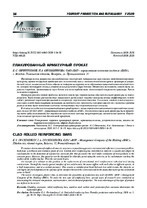| dc.contributor.author | Овчинников, Е. С. | |
| dc.contributor.author | Овчинникова, И. А. | |
| dc.coverage.spatial | Минск | ru |
| dc.date.accessioned | 2020-10-08T12:40:18Z | |
| dc.date.available | 2020-10-08T12:40:18Z | |
| dc.date.issued | 2020 | |
| dc.identifier.citation | Овчинников, Е. С. Плакированный арматурный прокат = Clad rolled reinforcing bars / Е. С. Овчинников, И. А. Овчинникова // Литье и металлургия. – 2020. – № 3. – С. 56-58. | ru |
| dc.identifier.uri | https://rep.bntu.by/handle/data/80715 | |
| dc.description.abstract | Преждевременное разрушение железобетонных конструкций, подвергаемых агрессивному воздействию окружающей среды, является серьезной проблемой как с технической, так и с экономической точки зрения. Арматура из углеродистой стали, заложенная в бетон, обычно не подвержена коррозии из-за образования защитной ионно-оксидной пленки, которая пассивирует сталь в условиях сильных щелочей в порах бетона. Однако эта пассивность может быть нарушена хлоридами, проникающими через бетон, или из-за карбонизации, достигающей поверхности арматуры. Затем начинается коррозия. Примером решения данной проблемы является замена при строительстве обычной стальной арматуры на плакированную. Через близко расположенные поверхности раздела двух твердых металлов атомы диффундируют между собой с различной скоростью при высокой температуре, определенном давлении. Тем самым, создается металлургическая связь между двумя твердыми металлами, целостность или «прочность» которых зависит от «чистоты» границы раздела между двумя металлами и атомов, составляющих эту «переходную зону» или связь. В статье исследуется плакированный арматурный прокат с целью определения возможности производства в условиях стана 320 ОАО «БМЗ – управляющая компания холдинга «БМК». Для изучения нового вида арматуры были проведены такие виды исследований, как определение химического состава, микроструктуры, механических свойств. Определены основные преимущества данного вида продукции. | ru |
| dc.language.iso | ru | ru |
| dc.publisher | БНТУ | ru |
| dc.title | Плакированный арматурный прокат | ru |
| dc.title.alternative | Clad rolled reinforcing bars | ru |
| dc.type | Article | ru |
| dc.identifier.doi | 10.21122/1683-6065-2020-3-56-58 | |
| local.description.annotation | Premature destruction of reinforced concrete structures exposed to aggressive environmental influences is a serious problem, both from a technical and economic point of view. Carbon steel reinforcing bar embedded in concrete is usually not subject to corrosion due to the formation of a protective ion-oxide film that passivates the steel under conditions of strong alkalis in the concrete pores. However, this passivity can be disrupted by chlorides penetrating the concrete, or by carbonation reaching the surface of the reinforcing bar. Then the corrosion begins. An example of a solution to this problem is the replacement of conventional steel reinforcement with clad steel during construction. Through the closely spaced interface of two solid metals, the atoms diffuse with each other at different speeds, at a high temperature, and at a certain pressure. This creates a metallurgical bond between two solid metals, the integrity or «strength» of which depends on the «purity» of the interface between the two metals and on the atoms that make up this «transition zone» or bond. The article investigates plated rebar, to determine the possibility of production in a mill 320 OJSC «BSW – Management Company of the Holding «BMC». To study the new type of reinforcing bars, special types of research were conducted as determining the chemical composition, microstructure, and mechanical properties. The main advantages of this type of product are defined in the article. | ru |

